UPDATE: USSF National Instructor and Assessor Jim Allen, who operates http://www.askasoccerreferee.com, weighs in on this case study. See bottom of the post.
In the Boxing Day match between Newcastle United and Manchester United, a goal was awarded to Newcastle United in the 28 minute after a lengthy discussion between the referee and assistant referee. The referee of the match was Select Group and FIFA referee Mike Dean. Assistant Referee 1 was Select Group and FIFA Assistant Referee Jake Collins.
In the 28 minute of play, a Newcastle player took a shot from just outside the penalty area of Manchester United. At the moment the ball was struck, Newcastle attacker Papa Cisse is clearly in an offside position. The shot, however, took a deflection off Manchester United defender Jonny Evans, who was marking Cisse. The deflected ball then ended up in the net.
AR Collins raises his flag for offside ostensibly because Cisse makes a play for the ball. It would have been difficult for the AR to know that Cisse had not actually touched the ball and that it had deflected in off of defender Evans. After referee Dean consulted with AR Collins, Dean decided to award the goal to Newcastle.
This much is clear about the Newcastle attacker, Cisse:
- he is in an offside position
- he makes a play for the ball
- he does not touch the ball
So, knowing these facts, we must evaluate whether to declare Cisse offside, thereby nullifying the goal, or allow the own goal to stand.
To evaluate the position of Cisse, we refer to three important documents:
- the Laws of the Game
- the Interpretation of the Laws of the Game for Referees
- Advice to Referees on the Laws of the Game, aka “ATRs” (A USSF publication)
Law 11 states, in part:
[box]A player in an offside position is only penalized if, at the moment the ball touches or is played by one of his team, he is, in the opinion of the referee, involved in active play by:
- interfering with play or
- interfering with an opponent or
- gaining an advantage by being in that position[/box]
To further clarify, we now refer to the Interpretations book, Law 11, which states, in part:
[box]
- “interfering with play” means playing or touching the ball passed or touched by a team-mate
- “interfering with an opponent” means preventing an opponent from playing or being able to play the ball by clearly obstructing the opponent’s line of vision or movements or making a gesture or movement which, in the opinion of the referee, deceives or distracts an opponent
- “gaining an advantage by being in that position” means playing a ball that rebounds to him off a goalpost or the crossbar having been in an offside position or playing a ball that rebounds to him off an opponent having been in an offside position
[/box]
Based on this documentation, we can conclude that Cisse is not interfering with play, as he did not touch the ball, and neither is he “gaining an advantage by being in that position”. If offside is to be the decision in the case, therefore, it must be because Cisse is interfering with an opponent.
Finally, we refer to the ATRs, which state, in part:
[box]A player who is in an offside position when the ball is played toward him by a teammate and who, in the opinion of the referee, attracts the attention of an opponent, drawing that opponent into pursuit, is guilty of interfering with an opponent.[/box]
The zoomed image below clearly indicates that Cisse has “attracted the attention of an opponent” because defender Evans is in contact with Cisse.
Based on this information, I believe that Cisse is indeed offside and that the goal should not be given.
That being said, we have to remember that the referee crew does not have the benefit of multiple replay angles and zoomed images when making decisions. I believe that AR Collins raises his flag because he believes that Cisse played the ball (remember that Cisse attempted a backheel shot). After consultation with referee Dean, it becomes clear that Cisse did not touch the ball and so the goal is awarded. My guess is that whether Cisse was “interfering with an opponent” never came into the discussion. But, that is only my guess.
Retired Select Group and FIFA Referee Graham Poll says the referee crew got the decision right. Mr. Poll, of course, wouldn’t normally access the ATRs.
So the question is: am I right in my application of the ATR passage quoted above? If so, why does this appear to be inconsistent with the application of Law 11 in England, at least in this case?
The following comment from Jim Allen of http://www.askasoccerreferee.com was added on 31 Dec 2012.
[box style=”rounded shadow light-yellow”]This is a very close call. From the available evidence (two photos), it is impossible to decide one way or another. In such cases, we cannot do any better than to rely on the long-time guidance from the IFAB, FIFA, and the U. S. Soccer Federation: The referee must be completely sure that an offense has occurred before calling it. If the referee does not recognize a possible infringement as such and call it (either by whistling for the offense or invoking the advantage clause or making no call at all on a trifling offense), then that offense has not occurred.
We are very concerned, however, with the comment that the Advice to Referees (ATR) appears to offer guidance which is not backed by anything official. Obviously, we disagree. The original question breaks down the decision into its appropriate parts and comes down exactly where it should have: the core question (given the givens) is whether there was interference with an opponent, and THAT is solely a matter of judgment for which the IFAB’s own guidance is quite sufficient — blocking the path, blocking the vision, or acting to distract or deceive. The ATR does not say anything contrary to this. The citation from the ATR is merely a good, concrete example of what exactly is meant by “acting to distract or deceive”: If the actions of the attacker in an offside position “draw” or cause a defender to move in a way he would not likely have moved in the absence of the offside position attacker, that is interfering with an opponent. So it all comes down to the basic issue of determining whether any of the three elements of interfering with an opponent applied. Our opinion is that it is arguable either way. We see the possibility of the goalkeeper’s line of vision being blocked or at least hindered (given where the attacker was). We also see the possibility that the attacker in the offside position blocked a possible movement path by the defender. And there is also the possibility – though we have no information on what was happening in the second or two prior to the first still picture — that the attacker may have drawn the defender to be where he was at the moment the ball deflected off the defender’s knee. However, because these are all only possibilities, that does not negate the guidance from on high that the referee must be absolutely certain of the offense – any offense, not simply offside – before calling it.[/box]
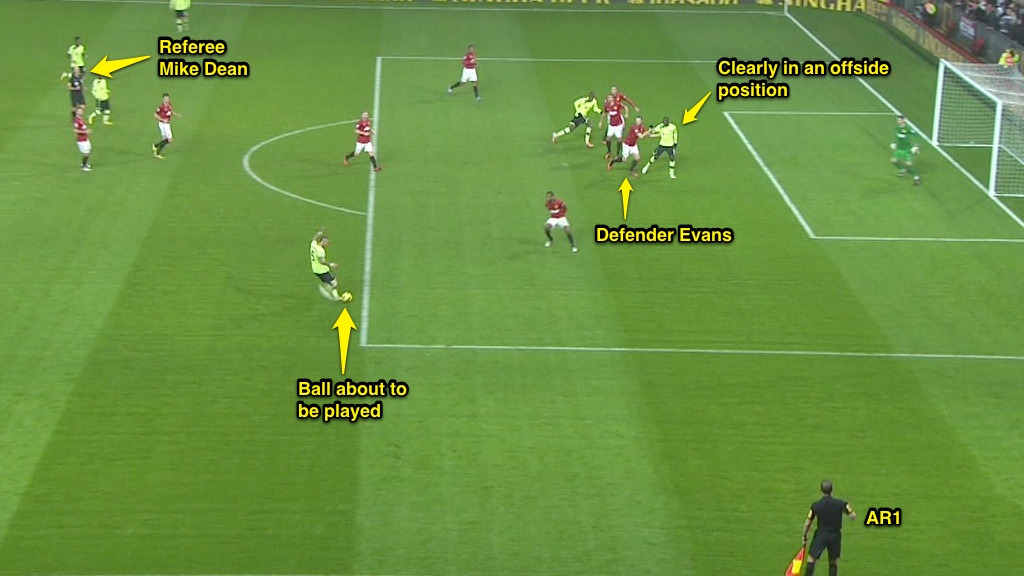
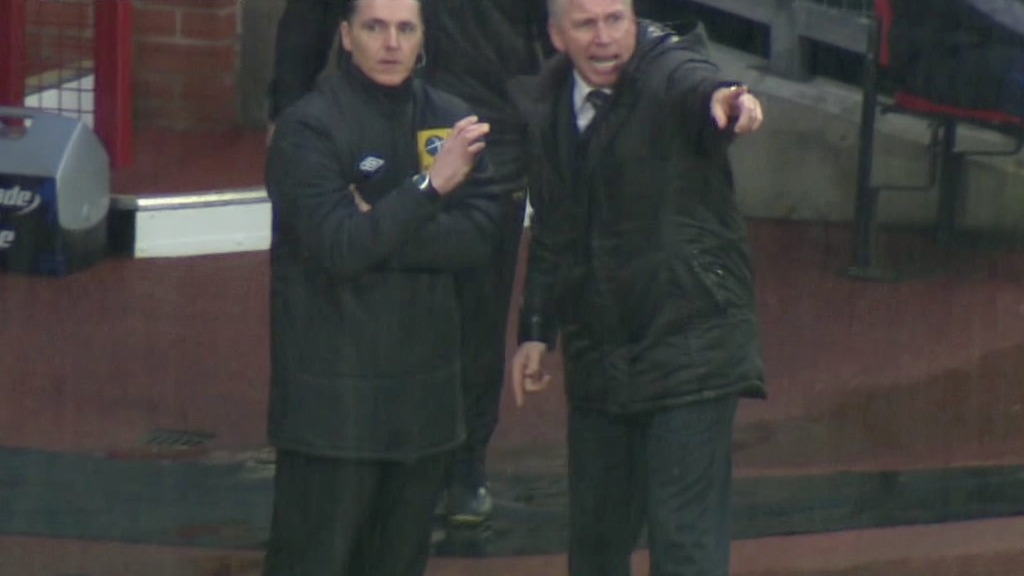
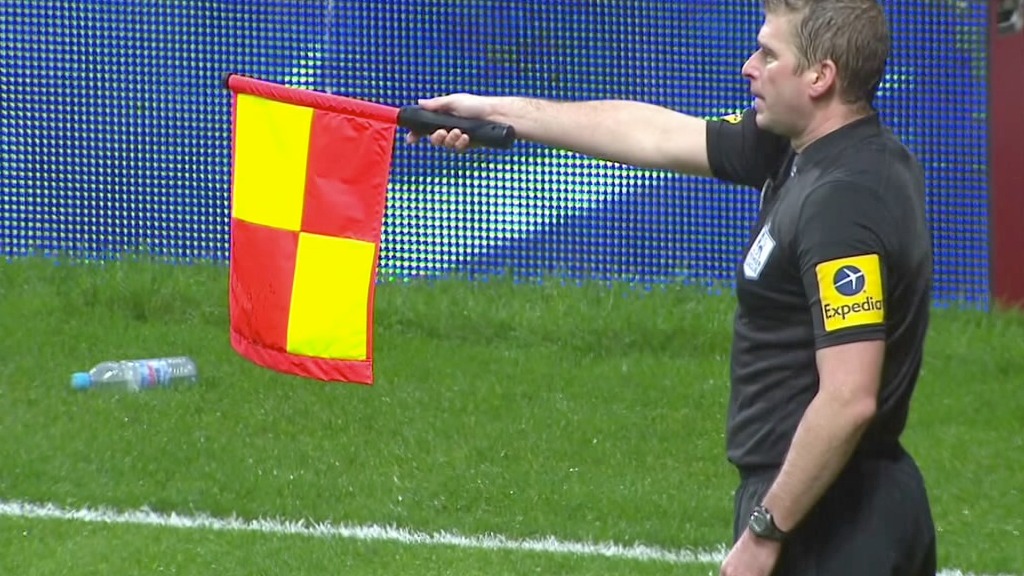
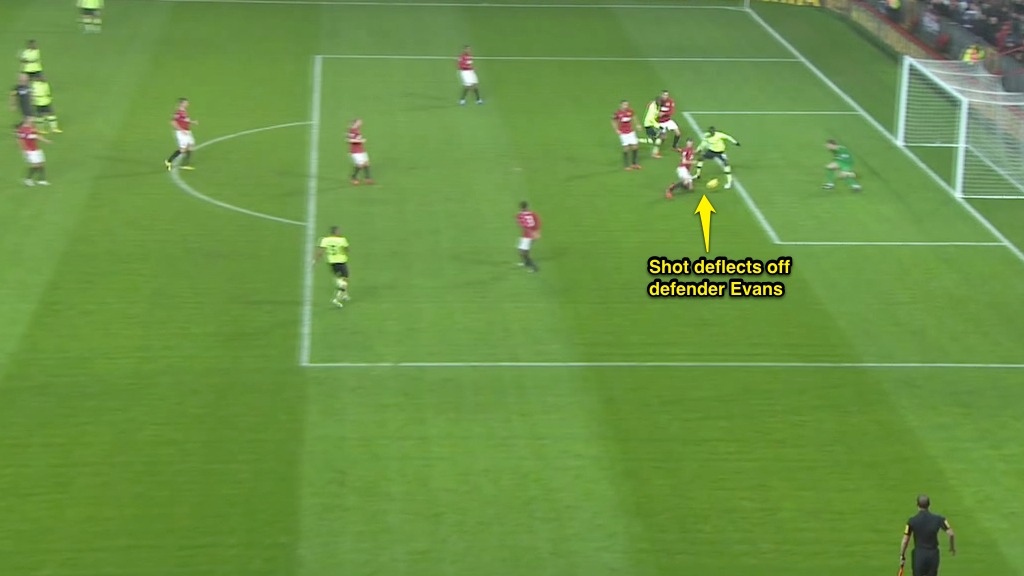
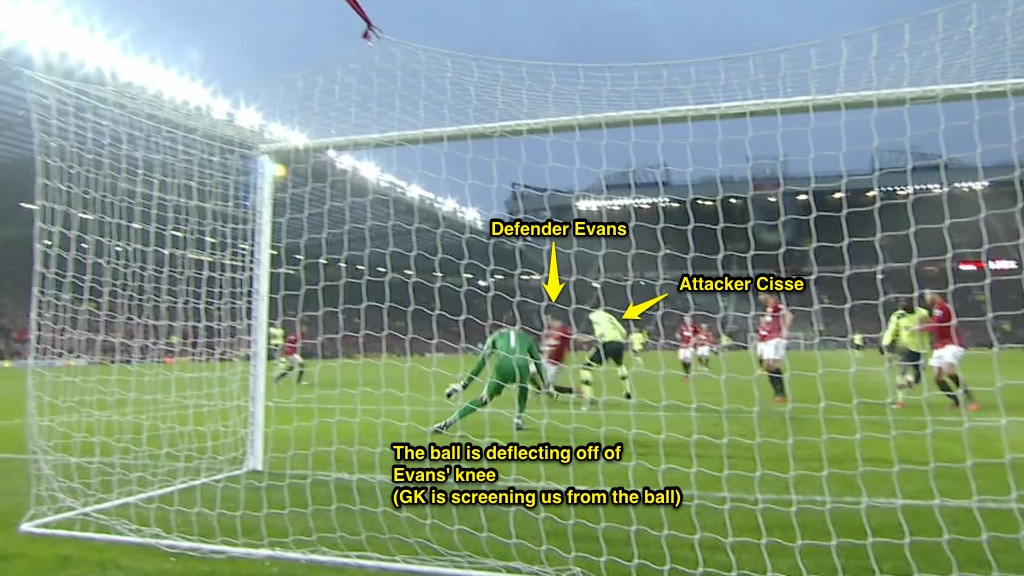
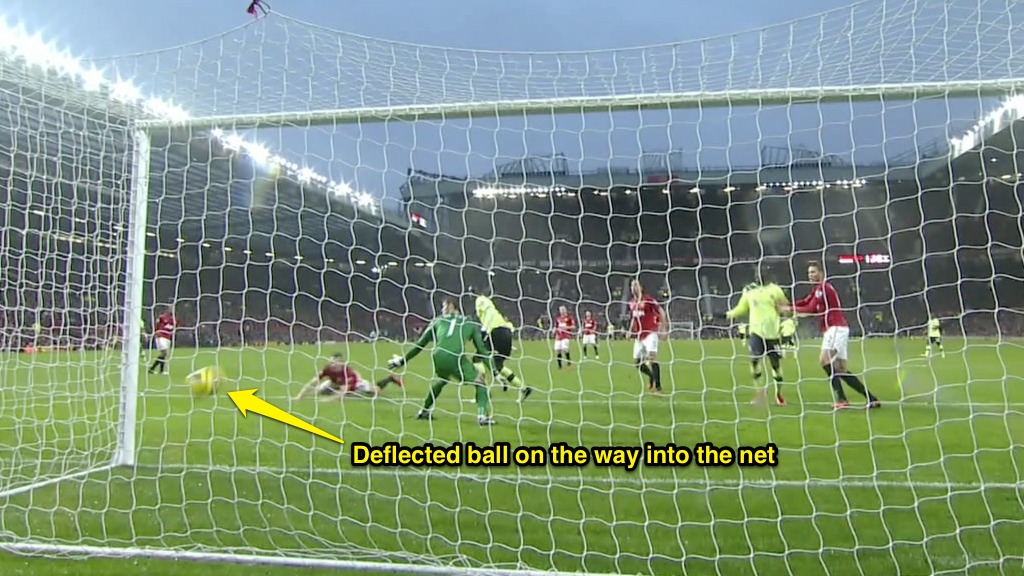
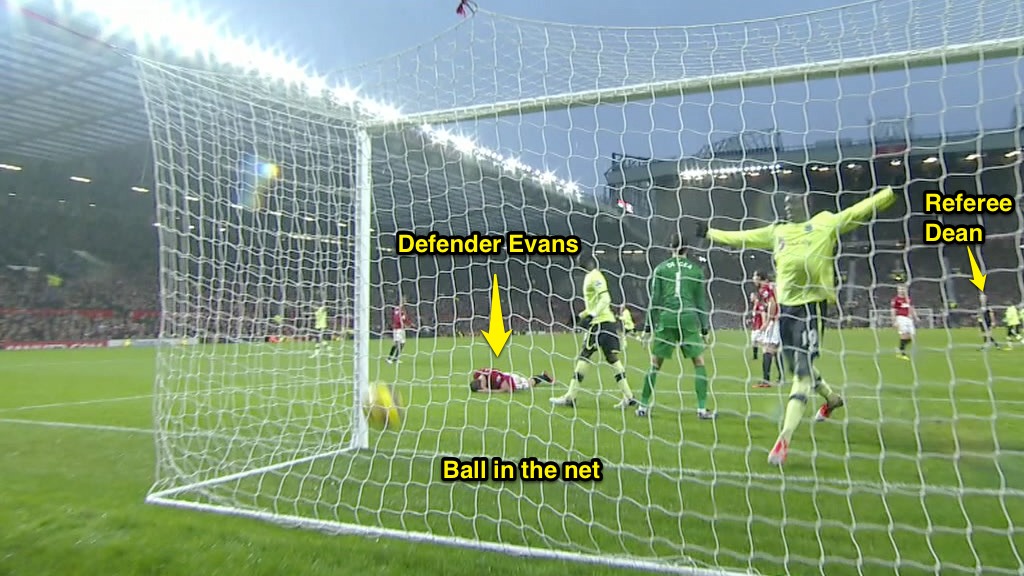
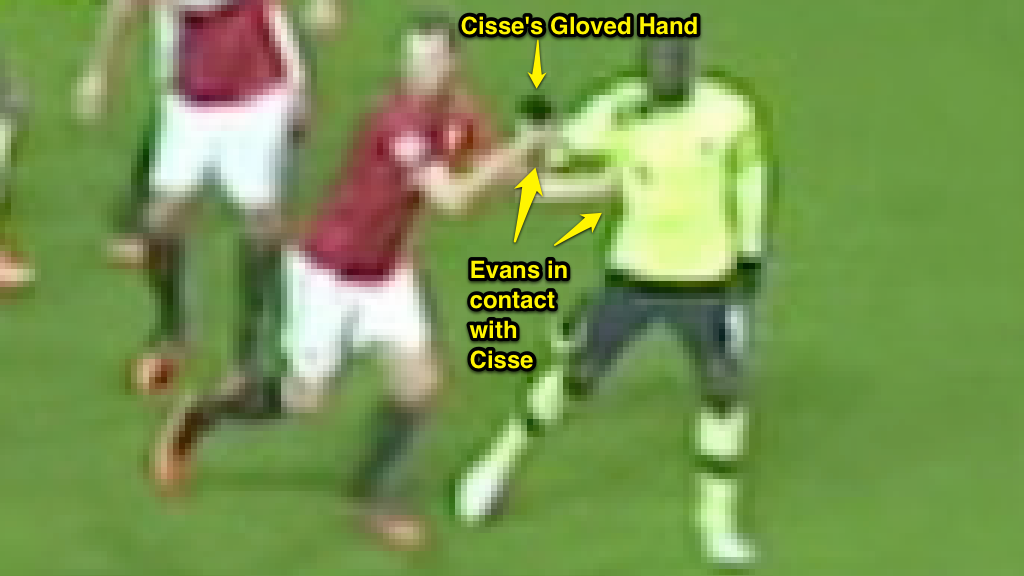
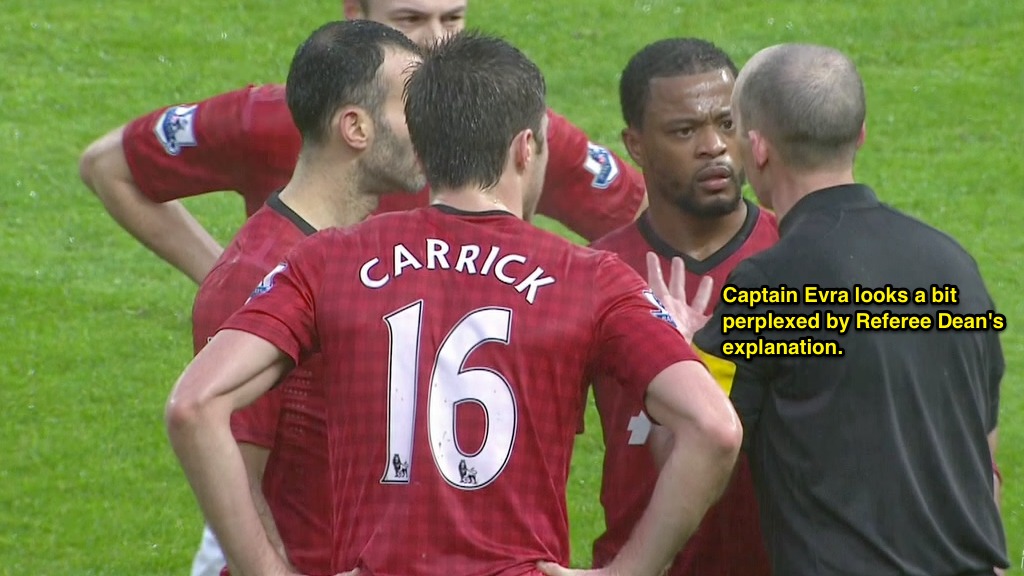
16 responses to “Case Study: Offside and Interfering With An Opponent”
I saw the game and I saw the replay and according to law 11 I feal the crew got it right. the offside player did not touch the ball and the defender did.
LikeLike
I saw it the same way. The attacker was interfering and, while in an offside position, caused the defender to make a play on the ball. I was surprised to see that the goal was allowed.
LikeLike
This was my assessment exactly.
LikeLike
I agree. He drew the attention of the defender, therefore interfering with an opponent. He did not need to contact the ball at all, which it appeared the attacked attempted to do and missed.
LikeLike
I agree as well. I am a youth and high school referee and I enjoy this FB site. I find it very helpful and insightful. Thanks.
LikeLike
Given the replay, it seems to me that Cisse caused the defender (Evans) to react to where he was AND in fact there is a case that the GK also was reacting to where Cisse was.
LikeLike
If Cisse hadn’t been there; the goal wouldn’t have happened. Side note: If deGea hadn’t been the keeper; the ball wouldn’t have gone in. Sell de Gea before it’s too late!
LikeLike
FW-you’ll go a long way w/an open mind 🙂
LikeLike
If Cisse wasn’t there… it never would have happened. By the way… Ferguson, sell de Gea… please!
LikeLike
Frederick Watson liked this on Facebook.
LikeLike
The attacking team did gain advantage by Cisse being in an offsides position. Unfortunately it’s easy to miss at the speed of play.
LikeLike
I agree with the assessment until the point of “Advice to the Referee” part because although I believe it should be in the Laws of the Game, it isn’t and so those that don’t use the ATR document because our FAs don’t guide us that way interpret this situation as not interfering with an opponent and therefore not offside. “Guiding them into a pursuit” would have been interpreted by Mike Dean and the AR that way when they changed their decision to allow the goal.
LikeLike
You make an excellent point, and I am in the process of seeking input from a higher authority on the ATR issue.
I know that individual FAs are not allowed to add anything that is contrary to the Laws Of The Game, so I feel certain there must be a basis for the ATR guidance.
LikeLike
The odd thing that I find though ITOOTR is that the USSF is in essence making a modification to the LOTG contrary to the ones allowed by IFAB. Although I agree with many of the comments in what I would label as ‘clarifications’, I heard from other sources that the USSF attempted to modify the length of the goal and approve helmets for goalkeepers at one point!
LikeLike
The Manchester United coach should have been dismissed 6 or 7 times.
LikeLike
I think that possibly I would have considered the likelyhood that the defender had been effectively drawn into a position where he gained potential ability to actually defend the shot better than he would have been otherwise … to me he was not ‘interferred’ with as he managed to contact the ball, deflect the shot and almost prevent the goal.
LikeLike